70: Woodblock and stencil : the spade courts
This is a presentation in a more straight forward fashion of the work done by Paul Bostock and me in our book of the same name.
I want to present a simplified version of the classification system of woodblock cards that Paul Bostock and I worked out a few years ago. Although the minute details may be of relevance in some cases, I have tried to reduce the characteristics of both the blocks and the stencils to give a reliable way of attributing court cards to a particular maker. It has to be borne in mind that many actual examples of packs are mixed as part of the recycling of secondhand cards (legally or otherwise) and sorting them into the makers who made the constituent cards is something that this classification is an attempt to help with. There are even examples of 51 cards by one maker and the AS by another.
The first and easiest analysis is into eye type. There are three, as follows:

Type I: the eye-balls are filled in from the corner to a straight line

Type II: the eye-balls are round in the centre of the eye or at the edge in the profile courts
These were the first types to develop after the end of the Blanchard era (roughly 1780 onwards); I exemplify below a pack of this earlier type by Blanchard.
 Blanchard, c.1760
Blanchard, c.1760
Types I & II were the main designs used from c.1780-1820. Towards the end of this period card-makers were beginning to modernize their courts and many of the makers had in-house designs to replace the older ones, which were shared across several makers. Two further versions of the wood-block courts appeared around 1820. One was shared by a number of makers: Type III.

Type III: round eye-balls, but simplified lines for facial features, e.g. single-line moustaches
The fourth and final type is really an in-house design belonging to Creswick, so I have designated it as CR1.
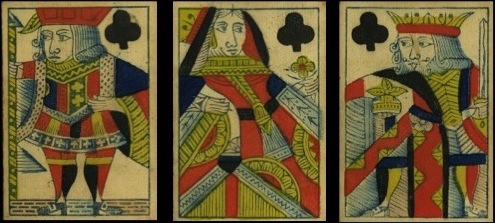 Creswick CR1: all eyes in profile with round eye-balls
Creswick CR1: all eyes in profile with round eye-balls
The odd thing about Creswick packs is that he doesn't seem to have redrawn any red jacks: they are either of Type II or Type III.
 CR1 with Type II red jacks (probably after taking over Stone's blocks/stock in 1825)
CR1 with Type II red jacks (probably after taking over Stone's blocks/stock in 1825)
 CR1 with Type III red jacks
CR1 with Type III red jacks
Although I have attributed this design to Creswick, I have recently acquired an interesting pack with CR1 courts with different colouring, Hall Type II red jacks and a Hall & Bancks Old Frizzle, which I find hard to explain (see page 69 for my collection).
King of Spades
As a first exemplification of the analysis of the outline block and the colour distribution, I'll take the KS.
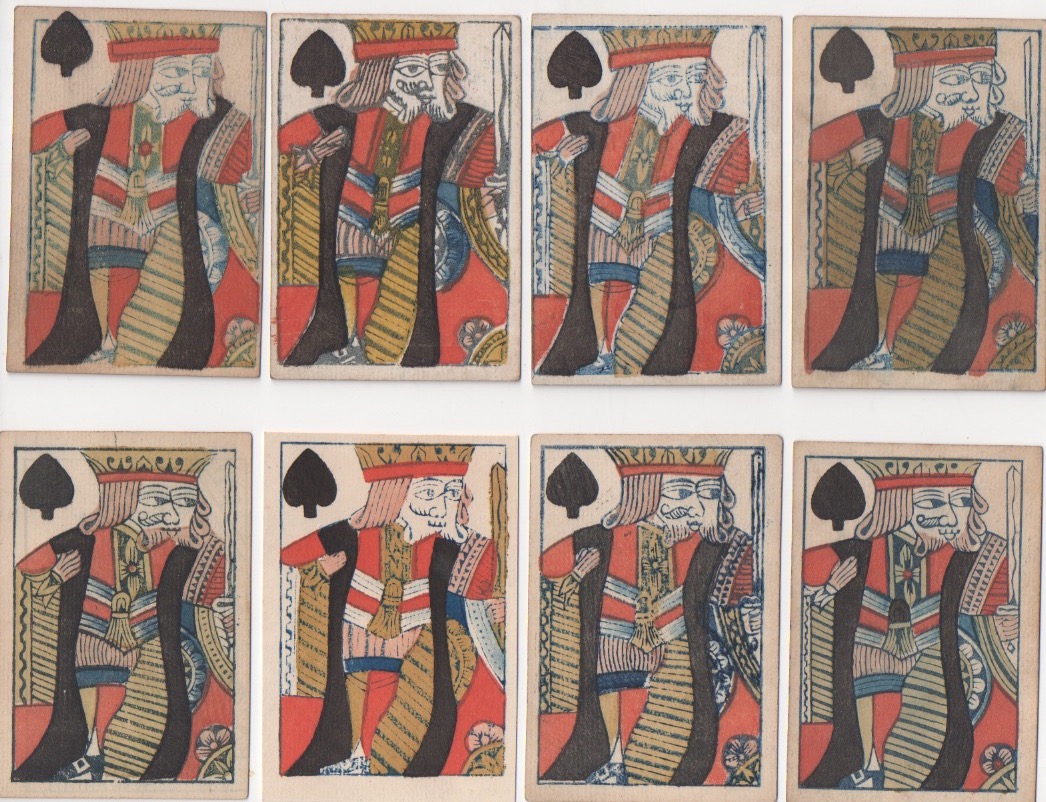
Top row: KS1(I)/KS1(II)/KS2/KS3
Bottom row: KS1b/KS2b/KS1a/KS1c
The characteristics I have used to arrive at these designations are as follows:
KS1 has alternating thick and thin stripes on his upper leg; note that this KS may appear with either Type I or Type II eyes. He also has crenellations on both his sleeves. KS1a has thin stripes only on his upper leg, only with Type I eyes in Hunt and Fuller packs, as far as I can tell; KS1b has dots on his sleeve on the right; KS1c has thin stripes and lines on his sleeve on the right; only in an odd pack by Fuller, as far as I know.
KS2 has cheek shading rather than a moustache; he is only found with Type II eyes; KS2a has the twig-like design found in KS3; KS2b has dots on his sleeve on the right.
KS3 has a wavy twig-like design on his sleeve on the right (= his left) (KS2a is the same design with Type II eyes, not illustrated).
These designations cover 46 of my wood-block packs; there are some further variations, but they don't add anything to the basic distinctions. For example, Stone and Creswick produced packs with elongated faces and Type II eyes, but the KS can still be aligned with one of the six types given above. In the Hall pack below some of the faces are all elongated, so I assume this is a mixed pack with the KS, K/Q/JD coming from a Stone/Creswick pack. (In my latest article in The Playing Card (2023), I suggest that Stone was the front man for Creswick, while the latter, as a papermaker, was prevented by law from making playing cards as well.)
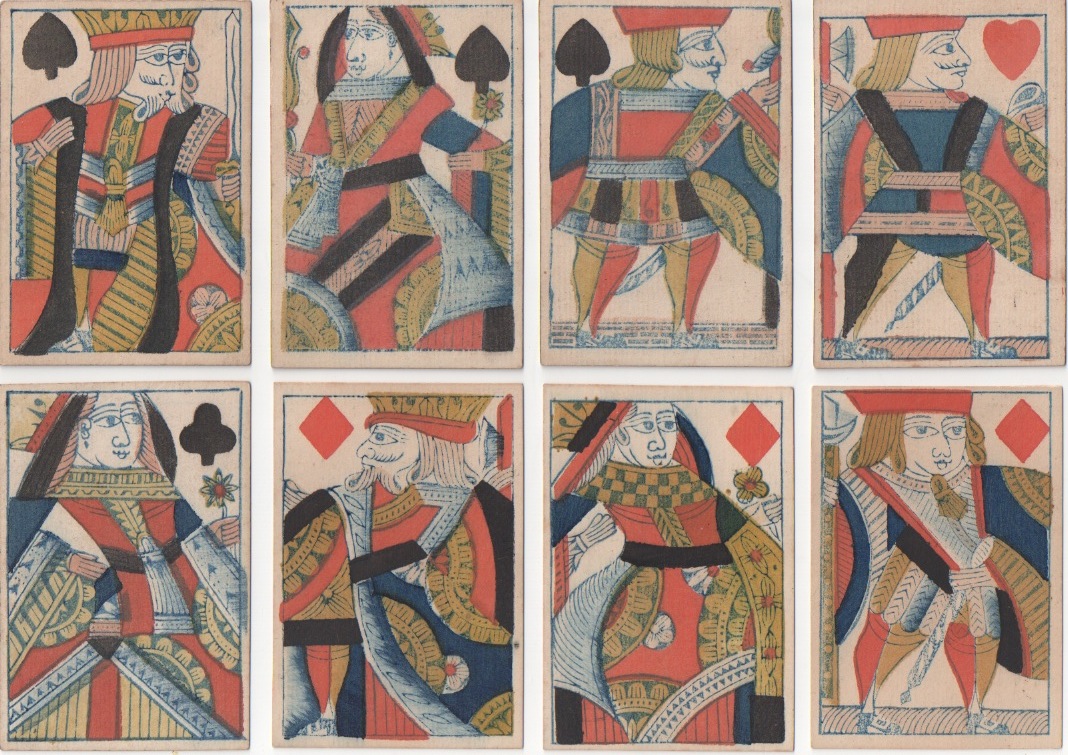
Queen of Spades
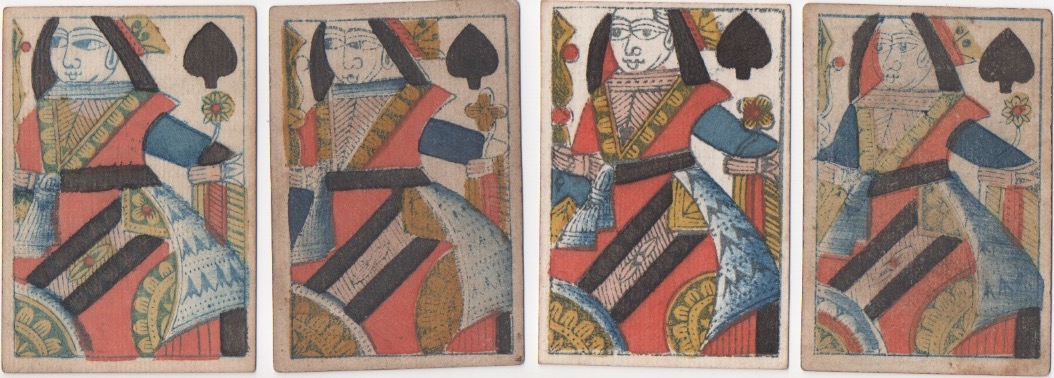
QS1(I) (x2)/QS1(II)/QS1a(II)
Main characteristics:
QS1 has yellow/red/yellow (Y/R/Y) on her sleeve on the right and her arm is lower than her shoulder; with Type I eyes her belt is horizontal, her head-dress on the left is all black and her sleeve is blue up to her flower and either black or white above her hand. With Type II eyes her belt is sloping, her head-dress is black and red and her sleeve is all blue; in variant QS1a her bodice is blue on the left. Except for QS1a, which always has Type II eyes, QS1 can have either eye type.
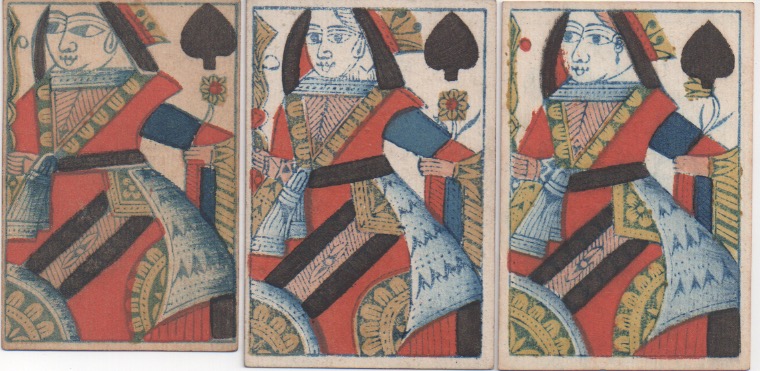
QS2(I)/QS2(II)/QS2a(II)
Main characteristics:
QS2 has R/blue (B)/Y on her sleeve on the right, her shoulder is below or just below her shoulder, and her upper sleeve is blue and red; with Type I eyes her belt is horizontal and her head-dress on the left is black and white, with Type II it is sloping, she has a lace collar by her cheek on the right by her head-dress and her head-dress on the left is black and red; QS2a holds a tulip and her upper sleeve is in line with her shoulder or just below it, a Hall variant.

QS3/QS4
Main characteristics:
QS3 has a sloping belt and black (Bk)/R/Y on her sleeve; she has blue and black on her upper sleeve, or it is all blue; her head-dress is black on the left. Type I eyes, and as far as I can tell, only used by Hardy.
QS4 has a long face (see the examples by Creswick above), B/R/Y on her sleeve and her upper sleeve is blue and yellow; her head-dress is black and red on the left. Used by Stone and Creswick. Note that the long-faced QS in the eight courts of the mixed pack above is QS2 by Hall.
Jack of Spades
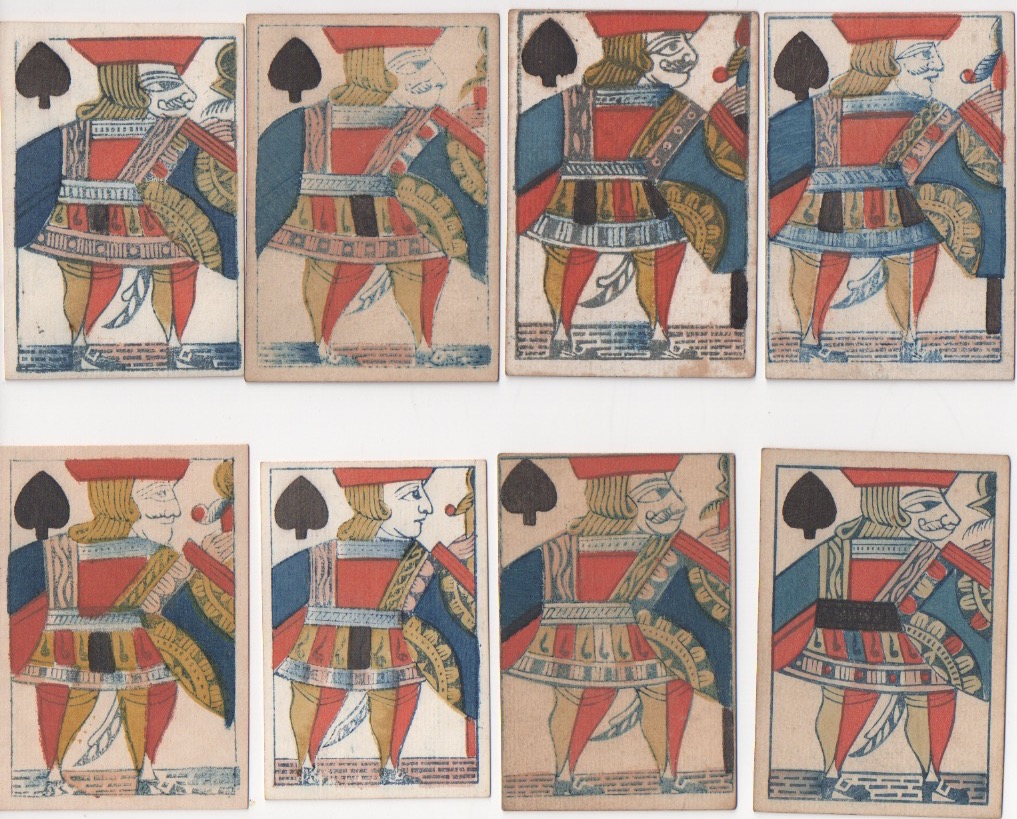
Top row: JS1/JS1a/JS2/JS2a
Bottom row: JS2b/JS2c/JS3/JS3a
JS1 has Type I eyes, a moustache and an odd attribute with no base, his sleeve on the right is level with his shoulder, his sleeve on the left is all blue. His tunic is coloured Y/R/Bk/R/Y/R. Example by Hunt. JS1a has Y/R/Y/Bk/Y/R on his tunic. Example by Stopforth.
JS2 has Type II eyes, a moustache and a pike with a base, his sleeve edge is above the level of his shoulder and it is flat at the bottom, his sleeve at the left is blue and red. The top of his sleeve has small circles. His tunic is coloured Y/Bk/Y/R/Y/Bk. JS2a is the same except that he has cheek shading and no circles on his sleeve. Both examples from Hall; the flat bottomed sleeve is replaced by a curved one in later examples. JS2b (by Stone) has an elongated face and no base to his pike. He has the tunic colouring of JS1a: Y/R/Y/Bk/Y/R. His leg at the left is coloured R/Y rather than the usual Y/R, which appears in other examples by Stone. JS2c is a one-off in a piquet-sized pack by Hall & Bancks. He is like JS2a but with the tunic colouring of JS1a and no moustache or shading.
JS3 is a mixture of the two types we've seen so far. He has Type I eyes and is like JS1a except that he has blue and red on his sleeve at the left and a base to his attribute. This example from T. Wheeler seems to have had the black on his tunic missed off in the stencilling process. JS3a is an odd example from Fuller (from the same pack as KS1c above) with the staff of his attribute completely missing and blue instead of black on his tunic (see the Hunt example of JS1 above). There are other Fuller packs with the usual black on the tunic and his sleeve in line with his shoulder (JS3b, not illustrated).
By Ken Lodge
United Kingdom • Member since May 14, 2012 • Contact
I'm Ken Lodge and have been collecting playing cards since I was about eighteen months old (1945). I am also a trained academic, so I can observe and analyze reasonably well. I've applied these analytical techniques over a long period of time to the study of playing cards and have managed to assemble a large amount of information about them, especially those of the standard English pattern. About Ken Lodge →

Leave a Reply
Your Name
Just nowRelated Articles
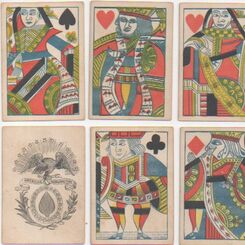
75: Early American cards
An overview of some of the early cards made in the United States.

Playing Cards: A Secret History
Playing Cards: A Secret History
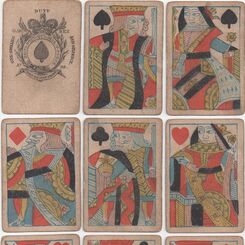
71: Woodblock and stencil: the hearts
A presentation of the main characteristics of the wood-block courts of the heart suit.
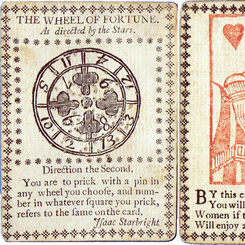
Fortune Telling playing cards
English Fortune Telling cards probably published c.1770.

Arms of English Peers
The Arms of English Peers playing cards were first published in 1686. Heraldry, or a knowledge of th...

Cribbage Board Collection part 2
A collection of antique and vintage Cribbage Boards by Tony Hall, part 2
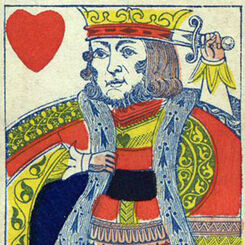
Suicide King
The King of Hearts, holding a sword behind his head, is sometimes nicknamed the “Suicide King”. He c...
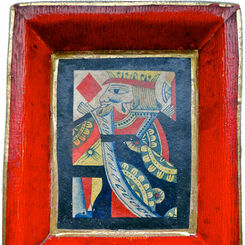
Pope Joan Trays
Some traditional Pope Joan boards comprise a circular tray, others are square, divided into sections...

19: 19th Century Breaks with Tradition - Unusual versions of the Standard English Pattern
The centuries-long tradition of English court cards was subject to misinterpretation and in some cas...
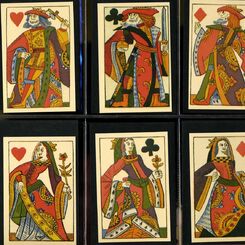
1: Playing Cards and their History: An Introduction and some links to other sites
What was considered the first mention of playing cards in England is in 1463 when Edward I banned th...

Mathematical Instruments
Mathematical Instruments playing cards forming an instrument maker's trade catalogue, Thomas Tuttell...
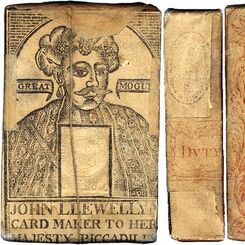
John Llewellyn, playing card manufacturer, London, 1778-1785
John Llewellyn, playing card manufacturer, London, 1778-1785

Reynolds c.1830
Woodblock and stencil playing cards, produced by Reynolds & Sons c.1830-1850.

Early Anglo-French Cards
Cards produced in Rouen during the sixteenth century. It was cards like these which were imported to...

History of Court Cards
The court cards in English packs of playing cards derive from models produced by Pierre Marechal in ...

Early English Playing Cards
Early examples of traditional, standard English playing cards of which the best known are those of H...

History of English Playing Cards & Games
The History of English Playing Cards dates probably from the mid 15th century

Cries of London
The cards were printed from copper plates, with the red suit symbols being applied later by stencil....

Hewson Replica Pack
Hand-made replica 17th century English playing cards, based on museum originals.

Woodblock and Stencil Playing Cards
Around 1987 I decided to make a pack of playing cards from woodblocks and coloured with stencils. I ...
Most Popular
Our top articles from the past 60 days


 Your comment here. Your comment here. Your comment here. Your comment here. Your comment here. Your comment here. Your comment here. Your comment here. Your comment here. Your comment here. Your comment here. Your comment here. Your comment here. Your comment here. Your comment here. Your comment here. Your comment here. Your comment here. Your comment here. Your comment here. Your comment here. Your comment here. Your comment here. Your comment here. Your comment here. Your comment here. Your comment here. Your comment here. Your comment here. Your comment here. Your comment here. Your comment here.
Your comment here. Your comment here. Your comment here. Your comment here. Your comment here. Your comment here. Your comment here. Your comment here. Your comment here. Your comment here. Your comment here. Your comment here. Your comment here. Your comment here. Your comment here. Your comment here. Your comment here. Your comment here. Your comment here. Your comment here. Your comment here. Your comment here. Your comment here. Your comment here. Your comment here. Your comment here. Your comment here. Your comment here. Your comment here. Your comment here. Your comment here. Your comment here.




















